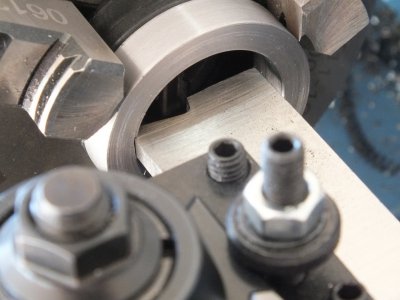- Joined
- Jan 8, 2020
- Messages
- 8
I am really pleased with the lathe in general. I bought the "deluxe" version a month or so ago. One issue is that the carriage wheel handle just clips the cross slide crank when the moon and stars are in a certain alignment. I can live with that. The DRO on the cross slide can interfere with rotating the compound. Hasn't been a major issue yet.
Where I do need some information is the drive belt. It looks like a 5mm pitch belt, but it isn't. Close as I can determine it is about 4.7 to 4.75mm pitch. That is a very strange size that I have not been able to locate anywhere. I did buy a 5mm pitch X 100 tooth belt in case I was measuring incorrectly. No go. Are there any other sources for these belts other than LMS and MM?
LMS is out of them as I write this. Chris was kind enough to recommend that I contact Micro Mark. I ordered two. Now I am not badmouthing Micro Mark because they had what I needed. But $46 for two belts (including shipping)? Normal, standard belts of this size are about $7 apiece and I can get them from my local Grainger with no shipping. It is not LMS's or Micro Marks fault someone designed a machine with odd belts. The belt is marked 1.5 X 100 and I cannot find anything even close on the web.
These are definitely wear items. And yes, I totally screwed up and wrecked the one that came with the lathe. I am thinking of replacing both the pulleys so a standard belt can be used. That could get tricky depending on the center distance between them.
The good news is that I totally enjoy using the lathe, even with the quirks mentioned above. Since I got it I have been tooling it up. Die holders, carriage stop and lock, tool post lock handle and even an ER-32 collet chuck. All made on the lathe except for the collet nut. I also have a MM hi torque mini mill which is a good machine. Added a simple reversing switch to it for $11 and that makes tapping really easy.
Where I do need some information is the drive belt. It looks like a 5mm pitch belt, but it isn't. Close as I can determine it is about 4.7 to 4.75mm pitch. That is a very strange size that I have not been able to locate anywhere. I did buy a 5mm pitch X 100 tooth belt in case I was measuring incorrectly. No go. Are there any other sources for these belts other than LMS and MM?
LMS is out of them as I write this. Chris was kind enough to recommend that I contact Micro Mark. I ordered two. Now I am not badmouthing Micro Mark because they had what I needed. But $46 for two belts (including shipping)? Normal, standard belts of this size are about $7 apiece and I can get them from my local Grainger with no shipping. It is not LMS's or Micro Marks fault someone designed a machine with odd belts. The belt is marked 1.5 X 100 and I cannot find anything even close on the web.
These are definitely wear items. And yes, I totally screwed up and wrecked the one that came with the lathe. I am thinking of replacing both the pulleys so a standard belt can be used. That could get tricky depending on the center distance between them.
The good news is that I totally enjoy using the lathe, even with the quirks mentioned above. Since I got it I have been tooling it up. Die holders, carriage stop and lock, tool post lock handle and even an ER-32 collet chuck. All made on the lathe except for the collet nut. I also have a MM hi torque mini mill which is a good machine. Added a simple reversing switch to it for $11 and that makes tapping really easy.


